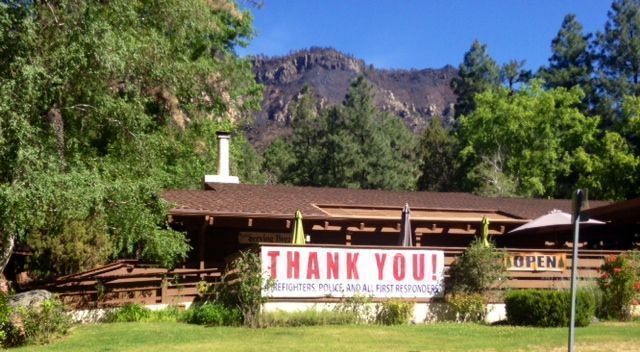There we were with Brian Williams, the lead-in story on NBC Nightly News two evenings in a row. Footage of huge flames storming up the rock walls in Oak Creek Canyon. A week later, for all that, the fire was well under control and Canyon residents were being permitted to return to their homes. Amazingly enough, no fire-fighters nor civilians had been injured and no structures destroyed. Thanks to readiness and vigorous action, Sedona treasures like Garland’s Lodge had escaped relatively unscathed. Even our beloved West Fork Canyon, though worse for the wear, was not, as we had feared, a total loss.
Although our mornings were often filled with smoke, the City of Sedona was never threatened. We had dodged another bullet, the second of two major forest fires in a decade that had made national headlines. In all, over 20,000 acres of forest to the north of us had burned, on top of the 4,000 that were torched in 2006. Although much larger, this one seemed to be less traumatic and over sooner. Fire officials and Canyon residents appeared to be far better prepared. Perhaps fire-fighting strategies and tactics have improved significantly in the past eight years. Certainly weather conditions came around to our side.
In the course of the week following the initial flare up, it was clear that the fire crews were gaining the upper hand, but the fire continued to grow. Turns out that that was part of the overall containment strategy. At the outset, officials declared that the expected the eventual burn area to be about 23,000 acres. The perimeter of that area is largely bounded by forest service roads that served to establish extensive fire-breaks that would keep the fire inbounds. Inside that perimeter, fire crews carefully set low intensity fires to deprive the wild fire of fuel on which to grow. Essentially, they were doing controlled burns similar to the prescribed preventative burns we’ve grown accustomed to over the years in that forest area south of Flagstaff. In my conversation with a senior fire official, he estimated that of the acreage within the perimeter, 15,000 of it was controlled-burn. These are basically ground fires that consume debris up to about four feet above the forest floor without undue damage to mature trees. He maintained that this makes for a more healthy forest; one that is far less susceptible to future fires. He went on to say that the burned area would provide an effective fire buffer for next fifteen years or so.
Is that to say that we’re safe from forest fires for the foreseeable future? Hardly. “Eternal vigilance is the price of freedom.” But, the silver lining of this trauma is that, despite the displacement of Canyon residents and the damage that was done to the environment, Sedona area is stronger for it.
As much as we dislike the prospect of forest fires and the occasional flooding of Oak Creek, we seem to be better prepared for them. And, we can take some consolation in knowing that, unlike other parts of the nation, we don’t have to worry about continuous threats from earthquakes, hurricanes, tornados, and for that matter, Polar Vortices. I’ll take that trade-off.
Meanwhile, by the way, despite a temporary slow-down due the fire, the Sedona real estate market continues gain strength while maintaining price levels that are 21% above the 2011 Bottom and 34% below the peak in 2006. I’ll take that, too.
Dr. Roy Eleutherios Grimm is the Head of the Buyer’s Broker Group and a member of the Pennington-Grimm Team at Russ Lyon Sotheby’s International Realty. For questions or comments email Roy at [email protected] or visit www.SedonaRealEstate.com for the full statistical details.

